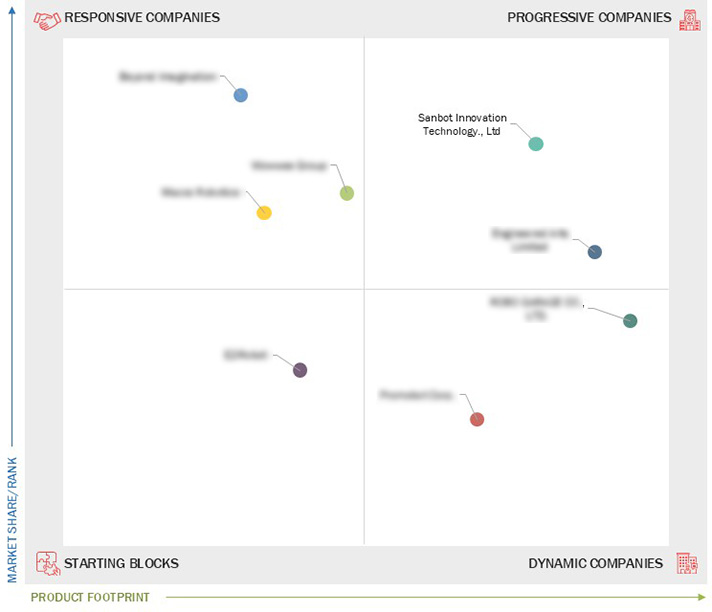Comparing 8 vendors in Humanoid Robot Startups across 0 criteria.
A humanoid robot resembles and imitates a human body structure and behavior. It has a torso, a head, two arms, and two legs; however, some humanoid robots may replicate specific parts of the human body. It is a complex machine equipped with hardware, software, and cutting-edge technologies to perform various tasks in different environments, such as deep-ocean exploration, scientific research, complex medical surgeries, and household chores. Their human-like form and behavior allow them to operate in environments designed for humans, making them more adaptable for tasks that require interaction with people or navigation in human-centric spaces. Humanoid robots are designed to assist in tasks ranging from personal assistance and caregiving to complex operations in logistics and manufacturing.
Market Leadership Quadrant
1.1 Study Objectives
1.2 Market Definition
1.3 Study Scope
1.3.1 Markets Covered and Regional Scope
1.3.2 Inclusions and Exclusions
1.3.3 Years Considered
1.4 Currency Considered
1.5 Unit Considered
1.6 Limitations
1.7 Stakeholders
2.1 Introduction
2.2 Market Dynamics
2.2.1 Drivers
2.2.1.1 Advancements in artificial intelligence and machine learning
2.2.1.2 Constant focus on developing humanoid robots with advanced features
2.2.1.3 Increasing use of humanoids in education sector
2.2.1.4 Surging deployment of humanoid robots in retail stores
2.2.1.5 Rising demand for humanoid robots from healthcare sector
2.2.2 Restraints
2.2.2.1 Requirement for significant capital investment and extensive R&D expenditure in humanoid robots
2.2.2.2 Performance limitations of humanoid robots in untested environments
2.2.3 Opportunities
2.2.3.1 Rapidly growing elderly population worldwide
2.2.3.2 Rising demand for humanoid robots from logistics sector
2.2.3.3 Increasing adoption of humanoid robots in search and rescue operations
2.2.4 Challenges
2.2.4.1 Increasing adoption of humanoid robots in search and rescue operations
2.2.4.2 Limited awareness about advantages of humanoid robots
2.3 Trends/Disruptions Impacting Customer Business
2.4 Value Chain Analysis
2.5 Ecosystem Analysis
2.6 Investment and Funding Scenario
2.7 Technology Analysis
2.7.1 Key Technologies
2.7.2 Complementary Technologies
2.7.3 Adjacent Technologies
2.8 Patent Analysis
2.9 Trade Analysis
2.10 Porter’s Five Forces Analysis
2.10.1 Threat of New Entrants
2.10.2 Threat of Substitutes
2.10.3 Bargaining Power of Suppliers
2.10.4 Bargaining Power of Buyers
2.10.5 Intensity of Competitive Rivalry
3.1 Introduction
3.2 Key Player Strategies/Right to Win
3.3 Revenue Analysis
3.4 Market Share Analysis
3.5 Company Valuation and Financial Metrics
3.6 Brand/Product Comparison
3.7 Company Evaluation Matrix: Startups/SMEs
3.7.1 Progressive Companies
3.7.2 Responsive Companies
3.7.3 Dynamic Companies
3.7.4 Starting Blocks
3.7.5 Competitive Benchmarking: Startups/SMEs
3.7.5.1 Detailed list of key startups/SMEs
3.7.5.2 Competitive benchmarking of key startups/SMEs
3.8 Competitive Scenario
3.8.1 Product Launches
3.8.2 Deals
3.8.3 Expansions
4.1 Sanbot Innovation Technology., Ltd
4.1.1 Business overview
4.1.2 Products/Solutions/Services offered
4.1.3 Recent developments
4.2 Engineered Arts Limited
4.2.1 Business overview
4.2.2 Products/Solutions/Services offered
4.2.3 Recent developments
4.3 Beyond Imagination
4.3.1 Business overview
4.3.2 Products/Solutions/Services offered
4.3.3 Recent developments
4.4 Wowwee Group Limited
4.4.1 Business overview
4.4.2 Products/Solutions/Services offered
4.4.3 Recent developments
4.5 Macco Robotics
4.5.1 Business overview
4.5.2 Products/Solutions/Services offered
4.5.3 Recent developments
4.6 Promobot Corp.
4.6.1 Business overview
4.6.2 Products/Solutions/Services offered
4.6.3 Recent developments
4.7 ROBO GARAGE CO., LTD.
4.7.1 Business overview
4.7.2 Products/Solutions/Services offered
4.7.3 Recent developments
4.8 Ez-Robot
4.8.1 Business overview
4.8.2 Products/Solutions/Services offered
4.8.3 Recent developments


 Robotics & Automation News
Robotics & Automation News
 Dec 2024
Dec 2024

